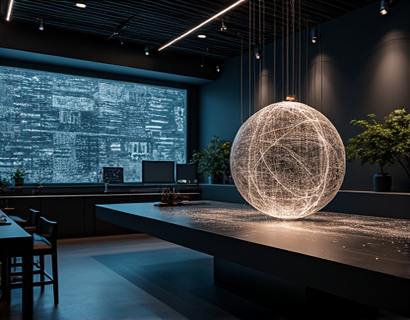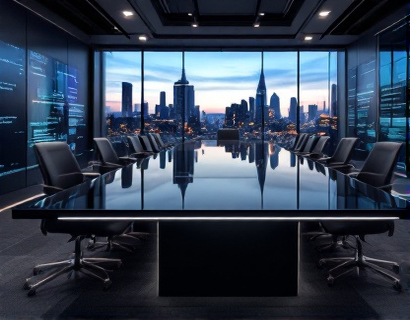Transforming Daily Life with Augmented Reality E-Commerce
In the rapidly evolving landscape of e-commerce, augmented reality (AR) has emerged as a transformative force, redefining how consumers interact with products and services. This technology, once confined to the realms of gaming and entertainment, is now being harnessed to enhance the shopping experience, offering a blend of the physical and digital worlds. For tech-savvy consumers eager to embrace the latest innovations, AR e-commerce presents a unique opportunity to elevate their lifestyle through cutting-edge products that seamlessly integrate into daily routines.
The core idea behind AR e-commerce is to provide users with an immersive and interactive shopping experience. Unlike traditional online shopping, where customers view static images or videos of products, AR allows them to visualize items in their own environment before making a purchase. This not only enhances the shopping experience but also reduces the likelihood of returns, as consumers can better assess how a product will fit into their space or complement their existing possessions.
Understanding Augmented Reality in E-Commerce
Augmented reality in e-commerce leverages the capabilities of smartphones and tablets to overlay digital information onto the real world. This is achieved through the device's camera, which captures the user's surroundings and superimposes virtual objects or information. For instance, a consumer looking to buy furniture can use an AR app to see how a sofa would look in their living room, adjusting the size, color, and position to find the perfect fit.
The technology behind AR e-commerce involves several key components. Computer vision algorithms analyze the camera feed to understand the environment, while 3D modeling and rendering techniques create realistic virtual objects. Machine learning algorithms further enhance the experience by personalizing recommendations based on user interactions and preferences. This synergy of technologies ensures a smooth and engaging user experience, making AR a powerful tool for e-commerce platforms.
Benefits of AR for Consumers
For consumers, the benefits of AR e-commerce are numerous. One of the most significant advantages is the ability to make more informed purchasing decisions. By visualizing products in their actual setting, consumers can better assess the fit, style, and functionality of items, leading to increased satisfaction and confidence in their choices. This is particularly valuable for high-ticket items such as furniture, home decor, and fashion, where the difference between a good fit and a poor one can be substantial.
Additionally, AR enhances the shopping experience by making it more interactive and fun. Instead of scrolling through endless product images, users can engage with products in a dynamic way, rotating items, changing colors, and even seeing how different accessories complement the main product. This level of interactivity not only keeps users engaged but also fosters a deeper connection with the brand, encouraging repeat visits and loyalty.
AR for Product Visualization
One of the most compelling applications of AR in e-commerce is product visualization. For consumers looking to refresh their living spaces, AR apps can transform the way they shop for furniture and decor. Imagine being able to see how a new coffee table would look in your living room, or how a particular piece of art would hang on your wall, without the need for physical samples. This not only saves time and effort but also reduces the environmental impact associated with returns and exchanges.
Fashion and beauty brands are also leveraging AR to enhance product visualization. Virtual try-on features allow users to see how clothes, accessories, and makeup would look on them without the need for physical try-ons. This is especially beneficial for online shopping, where the lack of physical interaction can be a significant barrier. By providing a realistic preview, AR helps consumers make more confident purchasing decisions, reducing the likelihood of returns and increasing overall satisfaction.
Personalization and Customization
AR e-commerce goes beyond mere visualization; it offers unprecedented levels of personalization and customization. Consumers can tailor products to their specific needs and preferences, creating unique items that reflect their individual style. For example, a furniture retailer might allow users to customize the color, material, and design of a chair, then use AR to see the final product in their home. This level of customization not only enhances the shopping experience but also increases the perceived value of the product.
Moreover, AR can be used to create personalized shopping assistants. These virtual assistants can guide users through the shopping process, offering recommendations based on their preferences and past purchases. By analyzing user data and behavior, these assistants can provide a highly personalized experience, suggesting products that align with the user's lifestyle and needs. This not only improves the shopping journey but also builds a stronger relationship between the consumer and the brand.
Enhancing Customer Engagement
AR e-commerce is not just about improving the shopping experience; it's also a powerful tool for enhancing customer engagement. Interactive AR experiences can turn a routine shopping trip into an exciting adventure, keeping users engaged for longer periods. Brands can create AR-based games, challenges, and interactive stories that encourage users to explore the platform more deeply. This increased engagement translates into higher user retention rates and a stronger brand presence.
Social sharing is another aspect where AR enhances customer engagement. Users can capture and share their AR experiences on social media, creating a viral marketing effect. For instance, a user might share a video of themselves trying on virtual makeup or arranging furniture in their home. This not only promotes the product but also showcases the brand's innovative approach, attracting new customers and fostering a community around the brand.
Challenges and Considerations
While the benefits of AR e-commerce are clear, there are several challenges and considerations that brands must address to implement this technology effectively. One of the primary challenges is ensuring a seamless and user-friendly experience. AR applications require high-performance devices and stable internet connections, which not all users may have. Brands need to optimize their AR experiences for a wide range of devices and network conditions to ensure broad accessibility.
Another consideration is the accuracy and realism of AR visualizations. Users expect virtual objects to blend seamlessly with their real-world environment, which requires advanced computer vision and rendering techniques. Brands must invest in high-quality 3D models and sophisticated algorithms to achieve this level of realism. Additionally, privacy and data security are critical concerns, as AR apps often require access to the user's camera and location data. Brands must prioritize transparency and security to build trust with their customers.
Future Trends in AR E-Commerce
The future of AR e-commerce is promising, with several trends poised to shape the industry. One significant trend is the integration of AR with other emerging technologies such as artificial intelligence (AI) and the Internet of Things (IoT). AI can enhance personalization by providing more accurate recommendations and predictive analytics, while IoT devices can create a more interconnected shopping experience. For example, a smart home system could automatically suggest furniture that complements the user's existing decor, based on real-time data from sensors and cameras.
Another trend is the rise of AR-powered virtual shopping assistants, which will become more sophisticated and integrated into the shopping journey. These assistants will not only help with product visualization and customization but also provide real-time support, answering questions and guiding users through the purchase process. As AR technology continues to advance, we can expect even more immersive and interactive experiences, blurring the lines between the physical and digital worlds.
Conclusion
Augmented reality e-commerce represents a significant leap forward in the way we shop online. By providing immersive, interactive, and personalized experiences, AR transforms the traditional e-commerce model into a more engaging and satisfying journey. For tech-savvy consumers eager to embrace the latest innovations, AR e-commerce offers a glimpse into the future of retail, where the boundaries of physical and digital shopping are seamlessly blended. As the technology continues to evolve, the potential for AR in e-commerce is vast, promising to revolutionize the way we discover, interact with, and purchase products.










































